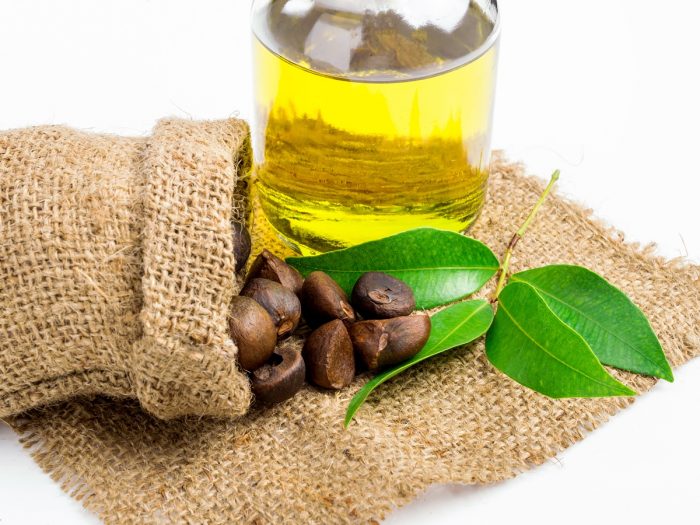Camellia oil might boast a huge list of health benefits including the ability to balance cholesterol levels, lower blood pressure, improve hair health, speed up wound healing, and reduce inflammation. It might also be good for skin care, bone health, boosting the immune system, and protecting against oxidative stress, among others.
What is Camellia Oil?
Camellia oil is also commonly known as tea seed oil, as it is the essential oil from the seeds of the tea plant. While the leaves of the tea plant are commonly dried to produce tea, the seeds can also undergo a cold-pressing or solvent extraction process to extract the concentrated oil. Thus, camellia oil maye benefit from many of the same antioxidant compounds as tea, but also has an extremely high level of unsaturated fats, as well as other minerals and nutrients. This oil may be widely used in Asia but has increased in availability around the rest of the world.
This potent oil can be made from the Camellia sinensis plant or the Camellia oleifera plant, whereas Japanese tea oil is made from Camellia japonica and has significantly different attributes. The oil may have a light green color and a mild smell, but it isn’t used as cooking oil, due to its bland flavor and relatively high cost. [1]
The many health benefits of camellia oil may be attributed to its high levels of oleic acid (more than 80%), as well as linoleic acid, alpha-linolenic acid, stearic acid, vitamin E, calcium, potassium, triterpenes, saponins, and squalane.

A bottle of camellia oil and some camellia seeds Photo Credit: Shutterstock
Camellia Oil (Tea Seed Oil) Uses and Benefits
Use of camellia oil might be popular for people struggling with high blood pressure, osteoporosis, high cholesterol, and inflammatory conditions. It might also treat cold, flu, respiratory infection, eczema, psoriasis, acne, weak immunity, brittle hair, hair loss, dandruff, and wounds.
Might Moisturize Skin
Research has shown that this oil may help smooth rough patches of skin and lock in moisture, that can make this an ideal remedy for people whose skin is regularly exposed to the elements. It can also minimize the appearance of wrinkles and keep your skin feeling young and healthy. [2]
Might Increase Hair Health
Another traditional use of camellia oil might be for strengthening and conditioning the hair. The rich supply of oils can coat your hair strands and moisturize your scalp, helping eliminate dandruff and prevent breakage and split ends.
Might Lower Blood Pressure
There may be a significant amount of potassium in camellia oil, so when used internally, it can have an impact on your blood pressure levels, due to its role as a vasodilator. However, the monounsaturated fats found in this oil can also positively affect hypertension. [3]
Might Treat Osteoporosis
With various minerals like calcium, phosphorus, and potassium in camellia oil, it might help maintain bone mineral density and slow down the onset of osteoporosis as you age. This can also minimize symptoms of osteoarthritis and generally increase the range of motion and mobility. [4]
Might Lower Cholesterol Levels
Camellia oil contains more than 90% unsaturated fats, which might make it a unique oil. Given the anti-inflammatory and cardioprotective nature of these oils, many people may turn to this natural remedy if they have high cholesterol. Moderate internal use of this oil can lower your chances of developing atherosclerosis. [5]
Might Reduce Joint Inflammation
There are a number of active components in camellia oil that might reduce inflammation in the tissues and joints including gamma-linolenic acid, oleic acid, and kaempferol, among others. These may help soothe symptoms of arthritis, gastrointestinal distress, respiratory conditions, and even headaches. [6]
Might Boost Immune System
Various substances derived from the Camellia sinensis plant including green tea and camellia oil might help strengthen the immune system and defend against bacterial and viral infections. This may be partly due to the level of triterpenes found in this oil, which might have been proven to have immune-boosting properties. [7]
Might Stimulate Wound Healing
This potent oil might be rich in vitamin E, which is an antioxidant that can stimulate blood flow to the skin and induce healing, as well as the growth of new cells. For wounds, scrapes, cuts, and bruises, topically applying a small amount of this oil may protect against infections and minimize the appearance of scars. [8]
Camellia Oil Side Effects
Camellia oil might have very few associated side effects but can cause skin inflammation, hypotension, and other negative reactions depending on its quality and processing method.
- May cause Irritation: Due to the high concentration of chemical compounds and fatty acids in camellia oil, it might cause skin irritation in some people when topically applied. To avoid this, apply a small amount to a patch of skin and wait for a few hours to see if a negative reaction occurs.
- Might lower Blood Pressure: The potassium content and blood-pressure-lowering effects of monounsaturated fats might be very helpful for people who are at risk of cardiovascular problems, but for those already taking medication for hypertension, this combined use can result in dangerously low blood pressure levels.
How to Select Camellia Oil?
Camellia oil may be rarely produced commercially outside of China, so when buying this oil, always check the ingredients and look for a reputed brand. Many companies may supplant true camellia oil with filler oils, which could have gastrointestinal or allergic impacts, and won’t be as effective as a pure form of this oil.
